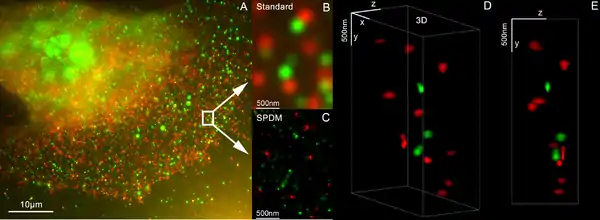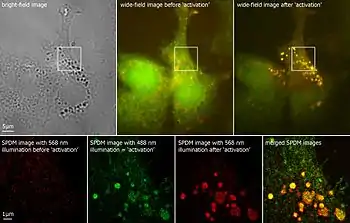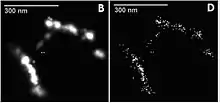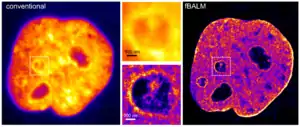Christoph Cremer
Christoph Cremer (born in Freiburg im Breisgau, Germany) is a German physicist and emeritus [1] at the Ruprecht-Karls-University Heidelberg, honorary professor at the University of Mainz[2] and was a former group leader at the Institute of Molecular Biology (IMB) at the Johannes Gutenberg University of Mainz, Germany, who has successfully overcome the conventional limit of resolution that applies to light based investigations (the Abbe limit) by a range of different methods (1971/1978 development of the concept of 4Pi-microscopy; 1996 localization microscopy SPDM; 1997 spatially structured illumination SIM).[3][4]
His actual microscope Vertico-SMI is the world's fastest nano light microscope that allows large scale investigation of supramolecular complexes including living cell conditions. It allows 3 D imaging of biological preparations marked with conventional fluorescent dyes and reaches a resolution of 10 nm in 2D and 40 nm in 3D.
This nanoscope has therefore the potential to add substantially to the current revolution in optical imaging which will affect the entire molecular biology, medical and pharmaceutical research. The technology allows the development of new strategies for the prevention, the lowering of risk and therapeutic treatment of diseases.
Biography
Following a few semesters studying philosophy and history at Freiburg University and Munich University, Cremer studied physics in Munich (with financial support from the Studienstiftung des Deutschen Volkes) and completed his Ph.D. in genetics and biophysics in Freiburg. This was followed by post-doctoral studies at the Institute for Human Genetics at Freiburg University, several years in the United States at the University of California, and his "Habilitation" in general human genetics and experimental cytogenetics at Freiburg University. From 1983 until his retirement, he was teaching as a professor (chair since 2004) for "applied optics and information processing" at the Kirchhoff Institute for Physics at the University of Heidelberg. In addition, he was a member of the Interdisciplinary Center for Scientific Computing Cremer was a participant in three "Projects of Excellence" of the University of Heidelberg (2007–2012), and was also a partner in the Biotechnology Cluster for cell-based and molecular medicine, one of five clusters selected in 2008 as German BMBF Clusters of Excellence. Elected as Second Speaker of the Senate of the University of Heidelberg, Cremer was also involved in university governance and politics. In his function as adjunct professor at the University of Maine and as member of the Jackson Laboratory (Bar Harbor, Maine), where he undertakes research for several weeks each year during the semester breaks, he was involved in the establishment of the biophysics center (Institute for Molecular Biophysics), which is linked with the University of Heidelberg through a "Global Network" collaboration.
Cremer is married to architect and artist Letizia Mancino-Cremer.
- Super Resolution Microscopy
 Breast Cancer Cells: 3D LIMON Dual Color Super Resolution Microscopy of Her2 and Her3 & cluster calculations
Breast Cancer Cells: 3D LIMON Dual Color Super Resolution Microscopy of Her2 and Her3 & cluster calculations SPDMphmyod: Single YFP molecule detection in a human cancer cell
SPDMphmyod: Single YFP molecule detection in a human cancer cell SPDMphymod Co- localisation microscopy of a nucleus: 120.000 GFP and RFP fusion proteins localized in a widefield view(470 µm2)
SPDMphymod Co- localisation microscopy of a nucleus: 120.000 GFP and RFP fusion proteins localized in a widefield view(470 µm2) Label-free Localisation Microscopy SPDM - Super Resolution Microscopy reveals prior undetebable intracellular structures
Label-free Localisation Microscopy SPDM - Super Resolution Microscopy reveals prior undetebable intracellular structures SMI Investigation of human eye tissue, affected by macular degeneration AMD
SMI Investigation of human eye tissue, affected by macular degeneration AMD Virus Super Resolution Microscopy SPDM Cremer/Wege labs
Virus Super Resolution Microscopy SPDM Cremer/Wege labs fBALM Super-resolution single molecule localisation microscopy using DNA structure fluctuation assisted binding activated localisation microscopy
fBALM Super-resolution single molecule localisation microscopy using DNA structure fluctuation assisted binding activated localisation microscopy
Fundamental developments
Developing the concept of 4Pi microscopy
Cremer was involved early in the further development of laser based light microscopy approaches. First ideas had their origin in his graduate student years in the 1970s. Jointly with his brother Thomas Cremer, now professor (chair) of Anthropology and Human Genetics at the Ludwigs-Maximilian University in Munich, Christoph Cremer proposed the development of a hologram-based laser scanning 4Pi microscope. The basic idea was to focus laser light from all sides (space angle 4Pi) in a spot with a diameter smaller than the conventional laser focus and to scan the object by means of this spot. In this manner, it should be possible to achieve an improved optical resolution beyond the conventional limit of approx. 200 nm lateral, 600 nm axial.[5][6] Since 1992, 4Pi microscopy has been developed by Stefan Hell (Max-Planck Institute for Biophysical Chemistry, Göttingen) into a highly efficient, high-resolution imaging process, using two microscope objective lenses of high numeric aperture opposing each other.[7][8]
Development of the first DNA laser-UV-microirradiation technique for living cells
In the early 1970s, the brothers realized a UV laser micro irradiation instrument which for the first time made it possible to irradiate in a controlled manner only a tiny part of a living cell at the absorption maximum for DNA (257 nm).[9] This replaced the conventional UV partial irradiation practiced for over 60 years. In this way, it was possible for the first time to induce alterations in the DNA in a focused manner (i.e. at predetermined places in the cell nucleus of living cells) without compromising the cells ability to divide and to survive. Specific very small cell regions could be irradiated and thus the dynamics of macromolecules (DNA) contained there quantitatively estimated. Furthermore, due to the high speed of the process using irradiation times of fractions of a second, it became possible to irradiate even moving cell organelles. This development provided the basis for important experiments in the area of genome structure research (establishing the existence of so-called chromosome territories in living mammalian cells) and led, a few years later (1979/1980) to a successful collaboration with the biologist Christiane Nüsslein-Volhard (Max Planck Institute for Developmental Biology, Tübingen). In this collaboration Cremer used his UV laser micro irradiation equipment to elicit cellular changes in the early larval stages of the fruit fly Drosophila melanogaster.[10][11]
Development of the confocal laser scanning microscopy for fluorescence
On the basis of experience gained in the construction and application of the UV laser micro irradiation instrument, the Cremer brothers designed in 1978 a laser scanning process which scans point-by-point the three-dimensional surface of an object by means of a focused laser beam and creates the over-all picture by electronic means similar to those used in scanning electron microscopes.[5] It is this plan for the construction of a confocal laser scanning microscope (CSLM), which for the first time combined the laser scanning method with the 3D detection of biological objects labeled with fluorescent markers that earned Cremer his professorial position at the University of Heidelberg. During the next decade, the confocal fluorescence microscopy was developed into a technically fully matured state in particular by groups working at the University of Amsterdam and the European Molecular Biology Laboratory (EMBL) in Heidelberg and their industry partners. In later years, this technology was adopted widely by biomolecular and biomedical laboratories and remains to this day the gold standard as far as three-dimensional light microscopy with conventional resolution is concerned.
Development of the super resolution microscopy methods
The goal of microscopy is in many cases to determine the size of individual, small objects. Conventional fluorescence microscopy can only establish sizes to around the conventional optical resolution limit of approximately 200 nm (lateral). More than 20 years after submitting the 4 pi patent application,[5][12] Christoph Cremer returned to the problem of the diffraction limit. With the Vertico SMI microscope he could realize his various super resolution techniques including SMI, SPDM, SPDMphymod and LIMON. These methods are mainly used for biomedical applications [13]
Spatially Modulated Illumination SMI
Around 1995, he commenced with the development of a light microscopic process, which achieved a substantially improved size resolution of cellular nanostructures stained with a fluorescent marker. This time he employed the principle of wide field microscopy combined with structured laser illumination (spatially modulated illumination, SMI)[14][15][16] Currently, a size resolution of 30 – 40 nm (approximately 1/16 – 1/13 of the wavelength used) is being achieved. In addition, this technology is no longer subjected to the speed limitations of the focusing microscopy so that it becomes possible to undertake 3D analyses of whole cells within short observation times (at the moment around a few seconds). Disambiguation SMI: S = spatially, M = Modulated I= Illumination.[17]
Localization Microscopy SPDM
Also around 1995, Cremer developed and realized new fluorescence based wide field microscopy approaches which had as their goal the improvement of the effective optical resolution (in terms of the smallest detectable distance between two localized objects) down to a fraction of the conventional resolution (spectral precision distance/position determination microscopy, SPDM; Disambiguation SPDM: S = Spectral, P = Precision, D = Distance, M = Microscopy).[18][19][20]
Localization Microscopy SPDMphymod
With this method, it is possible to use conventional, well established and inexpensive fluorescent dyes, standard like GFP, RFP, YFP, Alexa 488, Alexa 568, Alexa 647, Cy2, Cy3, Atto 488 and fluorescein. [21][22] in contrast to other localization microscopy technologies that need two laser wavelengths when special photo-switchable/photo-activatable fluorescence molecules are used. A further example for the use of SPDMphymod is an analysis of Tobacco mosaic virus (TMV) particles.[23][24] or virus–cell interaction.[25][26]
Disambiguation SPDMphymod: S = Spectral, P = Precision D = Distance, M = Microscopy, phy = physically, mod = modifiable
3D Light microscopical nanosizing (LIMON) microscopy
Combining SPDM and SMI, known as LIMON microscopy.[22] Christoph Cremer can currently achieve a resolution of approx. 10 nm in 2D and 40 nm in 3D in wide field images of whole living cells.[27] Widefield 3D "nanoimages" of whole living cells currently still take about two minutes, but work to reduce this further is currently under way. Vertico-SMI is currently the fastest optical 3D nanoscope for the three-dimensional structural analysis of whole cells worldwide [16] As a biological application in the 3D dual color mode the spatial arrangements of Her2/neu and Her3 clusters was achieved. The positions in all three directions of the protein clusters could be determined with an accuracy of about 25 nm.[28]
References
- "Fakultät für Physik und Astronomie".
- Honorary Professorship for IMB's Christoph Cremer
- http://www.kip.uni-heidelberg.de/AG_Cremer/de
- https://www.imb.de/research-at-imb/cremer/research/
- C. Cremer and T. Cremer (1978): Considerations on a laser-scanning-microscope with high resolution and depth of field Microscopica Acta VOL. 81 NUMBER 1 September, pp. 31—44 (1978)
- Cremer, T.; Cremer, C. (2006). "Rise, fall and resurrection of chromosome territories: a historical perspective Part II. Fall and resurrection of CTs during the 1950th to 1980th. Part III. Chromosome territories and the functional nuclear architecture: experiments and models from the 1990th to the present. In". European Journal of Histochemistry. 50: 223–272.
- Hell, S.; Lindek, S.; Cremer, C.; Stelzer, E. H. K. (1994). "Measurement of the 4pi-confocal point spread function proves 75 nm axial resolution". Applied Physics Letters. 64 (11): 1335–1337. Bibcode:1994ApPhL..64.1335H. doi:10.1063/1.111926.
- Hänninen, P. E.; Hell, S. W.; Salo, J.; Soini, E.; Cremer, C. (1995). "Two-photon excitation 4Pi confocal microscope - Enhanced axial resolution microscope for biological research". Applied Physics Letters. 68 (13): 1698–1700. Bibcode:1995ApPhL..66.1698H. doi:10.1063/1.113897.
- Cremer, C.; Cremer, T. (1974). "An ultraviolet Laser microbeam for 257 nm/Eine Laser-UV-Mikrobestrahlungsapparatur für 257 nm". Microscopica Acta. 75 (4): 331–337.
- Lohs-Schardin, M.; Cremer, C.; Nüsslein-Volhard, C. (1979). "A Fate Map for the Larval Epidermis of Drosophila melanogaster: Localized Cuticle Defects Following Irradiation of the Blastoderm with an Ultraviolet Laser Microbeam". Developmental Biology. 73 (2): 239–255. doi:10.1016/0012-1606(79)90065-4. PMID 115734.
- Nüsslein-Volhard, C.; Lohs-Schardin, M.; Cremer, C. (1980). "A dorso-ventral shift of embryonic primordia in a new maternal-effect mutant of Drosophila". Nature. 283 (5746): 474–476. Bibcode:1980Natur.283..474N. doi:10.1038/283474a0. PMID 6766208. S2CID 4320963.
- Cremer C, Cremer T (1971) Punkthologramme: Physikalische Grundlagen und mögliche Anwendungen. Enclosure to Patent application DE 2116521 "Verfahren zur Darstellung bzw. Modifikation von Objekt-Details, deren Abmessungen außerhalb der sichtbaren Wellenlängen liegen" (Procedure for the imaging and modification of object details with dimensions beyond the visible wavelengths). Filed 5 April 1971; publication date 12 October 1972.Deutsches Patentamt, Berlin. http://depatisnet.dpma.de/DepatisNet/depatisnet?action=pdf&docid=DE000002116521A
- "Biomedical applications for Super Resolution Microscopy". Archived from the original on 13 October 2016. Retrieved 13 October 2016.
- Heintzmann, R.; Cremer, C. (1999). "Lateral modulated excitation microscopy: Improvement of resolution by using a diffraction grating". Proc. SPIE. 3568: 185–196. Bibcode:1999SPIE.3568..185H. doi:10.1117/12.336833. S2CID 128763403.
- US patent 7,342,717, filed 10 July 1997: Christoph Cremer, Michael Hausmann, Joachim Bradl, Bernhard Schneider Wave field microscope with detection point spread function
- Baddeley, D.; Batram, C.; Weiland, Y.; Cremer, C.; Birk, U.J. (2007). "Nano-structure analysis using Spatially Modulated Illumination microscopy". Nature Protocols. 2 (10): 2640–2646. doi:10.1038/nprot.2007.399. PMID 17948007. S2CID 22042676.
- Best, G; Amberger, R; Baddeley, D; Ach, T; Dithmar, S; Heintzmann, R; Cremer, C (2011). "Structured illumination microscopy of autofluorescent aggregations in human tissue". Micron. 42 (4): 330–335. doi:10.1016/j.micron.2010.06.016. PMID 20926302.
- Bradl, J.; Rinke, B.; Esa, A.; Edelmann, P.; Krieger, H.; Schneider, B.; Hausmann, M.; Cremer, C. (1996). Bigio, Irving J; Grundfest, Warren S; Schneckenburger, Herbert; Svanberg, Katarina; Viallet, Pierre M (eds.). "Comparative study of three-dimensional localization accuracy in conventional, confocal laser scanning and axialtomographic fluorescence light microscopy". Proc. SPIE. Optical Biopsies and Microscopic Techniques. 2926: 201–206. Bibcode:1996SPIE.2926..201B. doi:10.1117/12.260797. S2CID 55468495.
- US patent 6,424,421, filed 23 December 1996: Christoph Cremer, Michael Hausmann, Joachim Bradl, Bernd Rinke Method and devices for measuring distances between object structures
- Heintzmann, R.; Münch, H.; Cremer, C. (1997). "High-precision measurements in epifluorescent microscopy - simulation and experiment". Cell Vision. 4: 252–253.
- Manuel Gunkel, Fabian Erdel, Karsten Rippe, Paul Lemmer, Rainer Kaufmann, Christoph Hörmann, Roman Amberger and Christoph Cremer: Dual color localization microscopy of cellular nanostructures. In: Biotechnology Journal, 2009, 4, 927-938. ISSN 1860-6768
- Reymann, J; Baddeley, D; Gunkel, M; Lemmer, P; Stadter, W; Jegou, T; Rippe, K; Cremer, C; Birk, U (May 2008). "High-precision structural analysis of subnuclear complexes in fixed and live cells via spatially modulated illumination (SMI) microscopy". Chromosome Research. 16 (3): 367–82. doi:10.1007/s10577-008-1238-2. PMID 18461478.
- Cremer, R. Kaufmann, M. Gunkel, S. Pres, Y. Weiland, P- Müller, T. Ruckelshausen, P. Lemmer, F. Geiger, S. Degenhard, C. Wege, N- A. W. Lemmermann, R. Holtappels, H. Strickfaden, M. Hausmann (2011): Superresolution imaging of biological nanostructures by spectral precision distance microscopy: Biotechnology 6: 1037–1051
- Manuel Gunkel, Fabian Erdel, Karsten Rippe, Paul Lemmer, Rainer Kaufmann, Christoph Hörmann, Roman Amberger and Christoph Cremer (2009): Dual color localization microscopy of cellular nanostructures. In: Biotechnology Journal, 2009, 4, 927-938. ISSN 1860-6768
- C. Cremer, R.Kaufmann, M. Gunkel, F. Polanski, P. Müller, R. Dierkes, S. Degenhard, C. Wege, M. Hausmann, U. Birk:"Application perspectives of localization microscopy in virology", Histochem Cell Biol (2014)
- Qiaoyun Wang, Rüdiger Dierkes, Rainer Kaufmanna, Christoph Cremer:"Quantitative analysis of individual hepatocyte growth factor receptor clusters in influenza A virus infected human epithelial cells using localization microscopy" Biochimica et Biophysica Acta (2014)
- P. Lemmer, M.Gunkel, D.Baddeley, R. Kaufmann, A. Urich, Y. Weiland, J.Reymann, P. Müller, M. Hausmann, C. Cremer(2008): SPDM – Light Microscopy with Single Molecule Resolution at the Nanoscale: in Applied Physics B, Vol 93, pp. 1-12
- Kaufmann, Rainer; Müller, Patrick; Hildenbrand, Georg; Hausmann, Michael; Cremer, Christoph (2010). "Analysis of Her2/neu membrane protein clusters in different types of breast cancer cells using localization microscopy". Journal of Microscopy. 242 (1): 46–54. doi:10.1111/j.1365-2818.2010.03436.x. PMID 21118230. S2CID 2119158.
External links
- History of Super Resolution Microscopy / Optical Nanoscopy
- Christoph Cremer's lab at the imb Mainz, Germany
- Official website
- List of publications
- Interview in World of Photonics
- Festschrift "Uncovering cellular sub-structures by light microscopy in honour of Professor Cremer's 65th birthday", European Biophysics Journal
- LuciaOptics